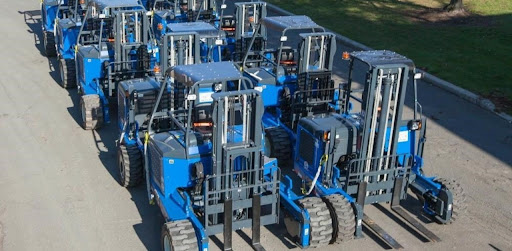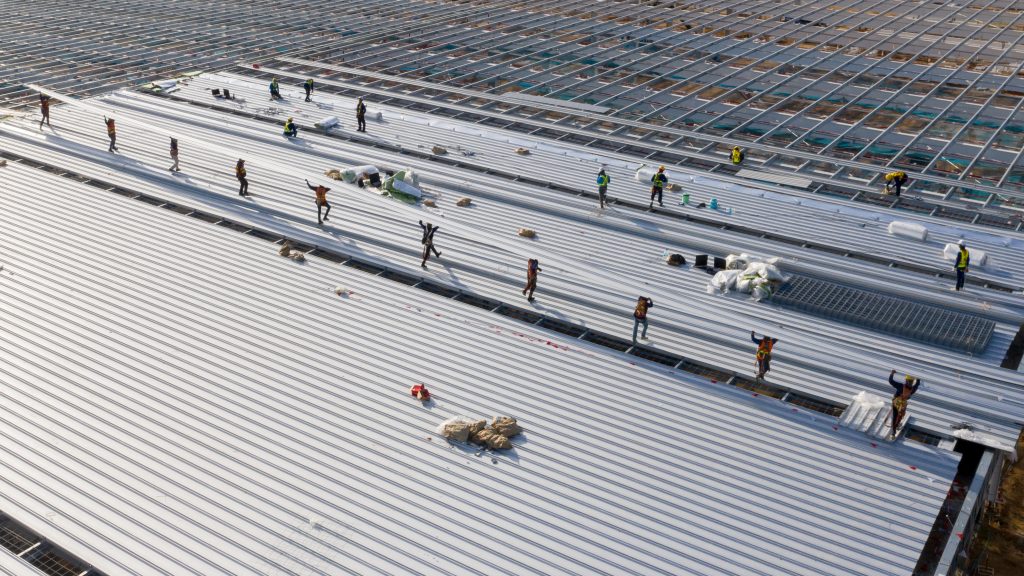Tech
How to Prepare Your Piggyback Forklift for Winters

Moffett forklift is a payload truck that has a forklift attached at the back which you can take anywhere. It’s a big convenience for truckers as it saves you a lot of time and money. For a vehicle that is all-wheel drive and can power through almost every ground condition, there is not a lot winters can do to it. With a locking differential that can lock the axles of the truck together to provide 100% of the torque with traction, you can expect to maneuver over hard terrains without really thinking about it. But every vehicle is still prone to slipping and requires special maintenance in the winter.
In this blog post, we will learn how to prepare for the cold season in a piggyback truck.
Maintaining a Moffett Forklift in Winters:
You can find used flatbed trucks for sale at almost half the price of a new one. It is a great way to save money. You can either get another one with the money you saved or invest it in your trucking business. Here are a few tips to prepare for the winter.
Winter Tyres:
Winter tyres are made from a softer rubber compound as compared to normal tyres. This allows them to conform to the conditions of the road and provide more traction and control. They have wider and complex tread patterns as well that help create channels for the snow and water to drain through, keeping the tyre relatively dry and enabling better grip.
Piggyback Truck Engine Heaters:
Engine block heaters are devices that plug into your house outlet through an extension cord and warm up the engine by bringing internal fluids up to temperature. For example an engine heater will heat up the coolant so it’s not frozen anymore and can quickly reach the engine to keep it running smoothly. This helps prevent any damage that may be inflicted on the truck due to idling or cold starts.
A trustworthy trucking company like Bobby Park Truck & Equipment prepares you for cold weather and teaches you how to take care of your truck properly.
Quick Winter Tips for your Moffett Forklift:
Following these quick tips can ensure you have a safe and sound working experience with your truck in winters.
- Always get regular maintenance for your truck and forklift
- Get a routine check up after every 90 days or 250 working hours
- Use oils that inhibit rust to save the truck’s internals from becoming weak
- Keep the forklift clean and make sure all exhaust pipes are clear with no residue blocking them
- Let the forklift run for a bit after starting it so the oil can circulate, same goes for the truck
- Ease your way into directional pedals and be patient with them
- Do not use hydraulics until their fluid is up to the right temperature
Do Regular Circle Checks:
A circle check makes sure the turck and the forklift are in optimal working condition by looking for things like physical damage to the truck and forks, and if there are any leaks in the engines. Making sure the lights work and cleaning them is also a part of this checkup. Refilling brake fluids and making sure the gearbox doesn’t make sounds due to winter jams all come in circle checks.
As you can see, there are a lot of things you can do to make sure your piggyback forklift keeps working in pristine condition during the winter. A piggyback truck is a great investment into the future of your trucking business. The real challenge is to maintain it in the winter. After reading this blog, we believe you are more than prepared to take care of your vehicle. With that said, let’s start trucking!
For further information, visit the FAQs section below.
FAQs:
Can you drive a forklift in the snow?
Yes, you can drive your forklift in the snow. However, it is recommended that you put on some winter tyres for it and be very careful on snow as you can slip easily.
Are forklifts gas or electric?
There are two main types of forklifts. Ones that run on battery and require regular charging. It is recommended that you don’t overcharge them and keep the battery percentage between 20% to 80% for better battery health. The other one has an internal combustion engine and uses petrol to operate.
When should a forklift be driven in reverse?
When coming down a ramp, you should always do it in reverse to balance the load properly.
Read also know about wnweekly

Tech
What Do CMMC Compliance Requirements Really Mean for Small Defense Contractors

For small defense contractors, meeting CMMC compliance requirements isn’t just another government regulation—it’s a necessity for staying in business. The Department of Defense (DoD) expects even the smallest contractors to follow strict cybersecurity measures to protect sensitive data. While compliance can feel overwhelming, understanding what it really means for operations, costs, and security can help businesses stay ahead.
Compliance Costs That Small Defense Contractors Rarely See Coming
The cost of CMMC compliance requirements isn’t just about buying better security tools—it involves ongoing expenses that many small contractors don’t anticipate. Beyond initial assessments and upgrades, businesses must account for long-term costs like continuous monitoring, staff training, and potential third-party audits. These hidden expenses can add up quickly, making it essential for small businesses to plan their budgets carefully.
One major cost driver is the need for documented security policies and technical upgrades to meet CMMC level 2 requirements. Businesses must implement multi-factor authentication, encrypted data storage, and access controls—none of which come cheap. Hiring cybersecurity professionals or working with managed service providers adds another layer of expense, but it’s often unavoidable. Contractors that underestimate these costs may struggle to maintain compliance, putting future contracts at risk.
Security Responsibilities That Go Beyond Just IT Departments
Many defense contractors assume that cybersecurity is solely the responsibility of the IT department, but CMMC requirements impact every employee. Security policies must be followed across all levels of the company, from executives to administrative staff. Human error remains one of the biggest cybersecurity risks, making ongoing training a key requirement under CMMC compliance.
Employees need to recognize threats like phishing scams, unauthorized data access, and improper file sharing. A single mistake—such as sending controlled unclassified information (CUI) over an unprotected email—can lead to compliance failures. To meet CMMC level 1 requirements, businesses must ensure that security practices become part of daily operations, not just a checklist item for IT teams. This cultural shift can take time, but it’s critical for long-term compliance.
Contract Opportunities That Disappear Without Proper Certification
For small defense contractors, failing to meet CMMC compliance requirements means losing out on valuable government contracts. The DoD is making CMMC certification a requirement for all contractors handling sensitive information, and without it, businesses will be ineligible to bid on projects. This shift is forcing many small companies to either adapt quickly or risk losing their competitive edge.
Even contractors that primarily work with larger defense firms must pay attention to compliance. Prime contractors are responsible for ensuring that their subcontractors meet the required security standards. Without CMMC certification, small businesses may find themselves cut out of subcontracting opportunities. Investing in compliance isn’t just about avoiding penalties—it’s about staying in the game.
Cyber Threats That Target Small Businesses Lacking Strong Defenses
Hackers don’t just target large defense contractors—small businesses are often seen as easy entry points into the supply chain. Many cyber criminals focus on smaller firms with weaker security, using them as gateways to steal classified data. CMMC requirements aim to close these gaps by enforcing strict security controls, even at the smallest levels of the defense supply chain.
Ransomware attacks, phishing schemes, and insider threats are all risks that small contractors face daily. Without proper cybersecurity measures, companies can fall victim to attacks that not only compromise data but also lead to non-compliance penalties. Meeting CMMC level 2 requirements ensures that businesses are protecting sensitive information while reducing their chances of becoming an easy target.
Documentation Burdens That Take More Time Than Expected
One of the most underestimated parts of CMMC compliance requirements is the level of documentation required. Small businesses must maintain detailed security policies, incident response plans, and risk assessments to prove compliance. This goes beyond simply having security tools in place—companies must be able to demonstrate their security practices through written records.
Keeping up with documentation can be time-consuming, especially for companies that don’t have dedicated compliance teams. Auditors will expect to see proof that security controls are actively managed and updated. Without thorough documentation, even businesses with strong cybersecurity practices may struggle to pass an assessment. Investing time in proper record-keeping now can prevent costly compliance failures later.
Government Scrutiny That Becomes More Intense with Each Audit
As the DoD tightens enforcement of CMMC compliance, small defense contractors should expect increased scrutiny during audits. Unlike previous cybersecurity requirements that allowed for self-assessments, CMMC compliance requires third-party certification. This means auditors will review policies, security measures, and implementation to ensure full compliance.
Each audit will bring a deeper level of examination, especially for companies handling CUI. Any gaps in security protocols can lead to failed assessments, forcing businesses to make costly corrections before they can regain compliance. Being proactive by staying updated with CMMC level 1 and level 2 requirements can help businesses avoid unexpected setbacks during audits.
Tech
Sustainable Commercial Roofing: Modern Approaches and Long-Term Benefits

Introduction to Sustainable Commercial Roofing
In recent years, the emphasis on sustainable business practices has gained significant momentum. Businesses are increasingly using sustainable solutions in their infrastructure, particularly in roofing, as they strive to lower their carbon footprint and comply with environmental standards. Commercial roofing plays a crucial role in not only the functionality of a building but also its ecological impact. Implementing sustainable roofs is quickly becoming a strategic choice, offering direct and indirect benefits that resonate with ecological consciousness and business efficiency.
With growing awareness of climate change, companies are looking for ways to minimize their environmental impact when it comes to commercial roofing installation. Sustainable roofing solutions provide a comprehensive approach, combining reduced energy consumption, improved efficiency, and eco-friendly materials. As the backbone of a building’s envelope, roofs significantly influence indoor environments and energy use. Thus, transitioning to sustainable roofing is more than just an eco-friendly gesture; it’s a savvy business move.
Advantages of Sustainable Roofing
One key advantage of sustainable roofing is the potential for substantial energy savings. These systems are designed to enhance temperature regulation, meaning reduced reliance on heating and cooling systems. Over time, this can result in significant cost reductions, which is essential for any firm to be viable. In essence, sustainable roofs contribute to lower operational costs while supporting environmental goals.
Beyond staffing savings, sustainable roofing systems also help lower waste production linked to conventional roofing materials and reduce harmful carbon emissions. Governments frequently offer tax breaks and subsidies to promote environmentally friendly building methods, which makes sustainable roofing even more alluring from a financial standpoint. These systems align with corporate social responsibility objectives and improve public perception and stakeholder engagement by showcasing a commitment to sustainability.
Types of Sustainable Roofing Materials
Sustainable roofing materials encompass a variety of innovative options, each offering unique benefits. Cool roofs, for instance, employ reflective materials to maximize sunlight reflection and minimize heat absorption, thus maintaining cooler building temperatures and enhancing energy efficiency. The U.S. Department of Energy highlights the benefits of cool roofing solutions, emphasizing their role in reducing urban heat islands and improving comfort.
Additionally, solar roofing tiles are becoming increasingly popular for businesses looking to harness renewable energy. By integrating photovoltaic technology into the roof, these tiles allow for on-site energy generation, further reducing reliance on external energy sources and lowering utility bills. Green roofs, on the other hand, consist of a layering of vegetation, which not only improves insulation but also promotes biodiversity and improves air quality.
Implementing Green Roofs in Commercial Spaces
Green roofs offer a multitude of ecological and architectural benefits. They consist of several layers, including waterproofing, insulation, and vegetation, helping to create a self-sustaining ecosystem on top of commercial buildings. These installations not only cut heating and cooling costs but also manage stormwater runoff effectively, lessening the impact of heavy rains and reducing strain on urban drainage systems.
From a business perspective, green roofs improve aesthetic appeal, which can increase property value and make a building more attractive to tenants. They also contribute to urban biodiversity by providing habitats for various species, making them a forward-thinking solution for urban development. Implementing green roofs helps businesses stand out as pioneers of sustainability, enhancing their reputation and engagement with environmentally conscious clients and partners.
Maintenance Tips for Longevity
Maintaining the longevity of sustainable roofing systems can be achieved through regular inspections and upkeep. Routine maintenance ensures that minor issues do not escalate into significant problems requiring costly repairs. Key aspects of maintenance include checking seals, cleaning gutters, and ensuring that any photovoltaic components are debris-free.
It’s crucial to employ methods and materials suited for the specific type of sustainable roofing. For example, green roofs may require regular care of vegetation and soil. By adopting a proactive maintenance approach, businesses can extend the life of their sustainable roofs, maximizing their investment over the years.
Survey of Industry Improvements and Innovations
The roofing sector is witnessing continuous innovation to enhance the performance and feasibility of sustainable solutions. Innovations include advanced materials that offer better durability and efficiency and integrated energy solutions like building-integrated photovoltaics (BIPV). According to innovations in roofing technology, the sector is experiencing a shift towards smarter, more sustainable materials, which make green options more accessible than ever before.
Emerging technologies are reducing the cost of implementation and improving the payoff from green investments. As technology advances, it is expected that sustainable roofing will become the norm, with increasingly sophisticated options available to commercial entities.
Real-Life Examples of Successful Projects
Several businesses across the globe have successfully implemented sustainable roofing projects, reaping both environmental and financial benefits. For instance, some urban areas have transformed their municipal buildings with green roofs, resulting not only in improved stormwater management but also in enhanced urban landscape aesthetics.
In another example, corporations have installed solar tiles, effectively cutting down their electricity bills and reliance on nonrenewable energy sources. These case studies demonstrate that the shift to sustainable roofing systems results in practical benefits and serves as an inspiration for other businesses looking to embark on similar journeys.
Tech
Tips For Learning How To Buy 500 Instagram Likes

Buy 500 Instagram likes and soon you’ll become even more popular and visible on the social networks of the world! It’s proven by experience that active users remove negativity from their lives, so come ready and welcome new horizons into your life. Instagram has become huge because of its viral capabilities to attract large numbers of users quickly. It’s no surprise then that its use could have a profound effect on your mental well-being. The use of photographs, videos, and images can help you reduce stress and boost your mood.
One way to buy 500 Instagram views is to become an active user in the popular microblogging website. Many users have an account and use it to share photos and videos they have taken with their devices, and also to show others what they have seen. In this way, they gain followers, and their account becomes popular. When you add the link to your page in your profile and fill out all the necessary data, you can start getting real friends. As you gain more followers, your position on the ladder of rankings within the network will rise as well. As your popularity increases, you’ll be able to see your profile page at the top of the list.
To buy 500 Instagram likes, first, you need to make an account. Then, go to the home page and scroll down to “Advertising” and click “Create account”. Follow the prompts, and fill out all the required information. You’ll then be asked to accept the terms and conditions and choose your username, password, and location.
Once you’ve created an account and have chosen a username, you can begin the process of how to buy 500 Instagram likes. Click “Connect” to begin the submission form. On the page, fill out all the requested information. After the submission is complete, you’ll be prompted to select a method of payment. The choices are PayPal or Google Checkout. If you select PayPal, you’ll be asked to enter your PayPal email address, which is how the money will be transferred to your account.
If you would like to know how to buy 500 Instagram likes, but don’t want to use PayPal, you can select the other two payment methods. To do so, navigate to the “Welcome” page and click “Connect”. On the page, click “Submit”, and then follow the prompts. Once you complete the connection, a verification email will be sent to your email address, confirming that the account is verified and that you have accepted the terms of service.
An Instagram buys 500 likes package allows you to buy individual photos and set them as your profile. You can even have groups with photos, which will allow you to sell multiple photos to interested buyers. The biggest advantage to this approach is that you are given the ability to build relationships with potential buyers who share an interest in social media marketing and selling social media marketing products and services. In addition, if you are unable to upload the images yourself, having someone else do it for you ensures that the image will be properly submitted to the various networks.
A more popular option when learning how to buy 500 Instagram likes is to use the instant likes feature offered by the network. This feature allows interested buyers to browse through photos immediately. If you haven’t built up much of a following on Instagram, it may take some time to see results from the many users browsing through the photos. However, if you have many followers, you should notice sales from this source, as sellers will want to reach as many potential buyers as possible. However, if you would prefer not to use an instant likes feature, you can always view the photos first and rank them based on popularity to gain more exposure.
The main benefit of the pay-per-sale approach is the ability to gain immediate sales without spending money upfront. This type of selling strategy offers marketers immediate sales with very little work. This means that sellers can gain immediate profits and cut back on advertising costs. With the pay per sale model, it takes a seller two to three weeks before the listing goes live on the network, but once it does go live, you can expect to receive immediate sales and commissions on every sale you make for the duration of the promotion. These are just some of the ways that you can take advantage of the instant social media marketing opportunity offered by social media networking sites like Instagram.

 Travel2 years ago
Travel2 years agoPractical And Essential Car Interior Accessories To Add Comfort And Convenience To Your Drive

 Business2 years ago
Business2 years agoTop Reasons Why you Need to Consider Outsourcing Real Estate Photo Editing

 Business2 years ago
Business2 years agoDead And Co Setlist What They Played At The Gorge Amphitheatre

 Featured2 years ago
Featured2 years agoHow to Make a Sports Career in India

 Health2 years ago
Health2 years agoGarlic Is The Best Vegetable To Treat Heart Problems

 Sports2 years ago
Sports2 years agoHow to watch the ETSU game -What are the benefits of watching the ETSU game?

 Health2 years ago
Health2 years ago5 Reasons to Choose Turkey for Dental Treatments

 Travel2 years ago
Travel2 years agoSpectacular Hot Air Balloon Rides in Goa